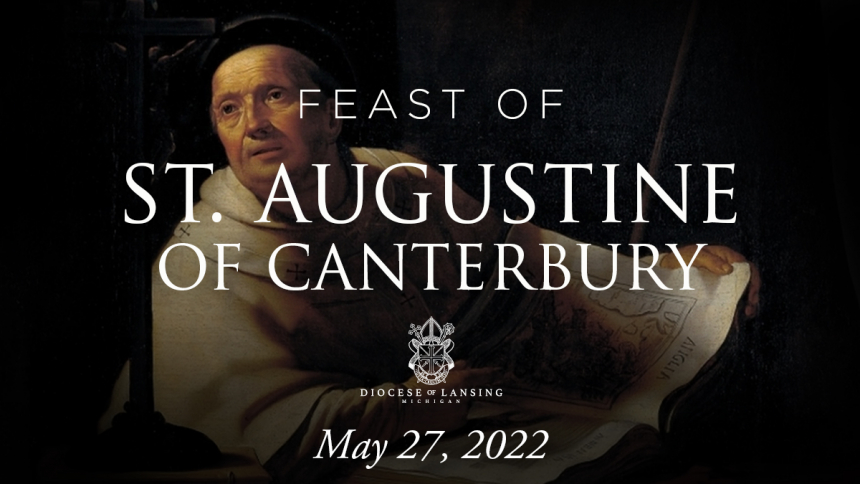
Today is the Feast of Saint Augustine of Canterbury, the Italian Benedictine monk who took the Catholic faith to England in the late 6th century. Happy feast day!
Michael Andrews, Chancellor of the Diocese of Lansing, now explains why he believes Saint Augustine's life is very relevant to contemporary attempts to bring the person of Jesus Christ and His Holy Church to modern society. Michael writes:
Recent popes have strongly emphasized the need for the New Evangelization, in other words, for the message of the Gospel to be re-proposed "to those regions awaiting the first evangelization and to those regions where the roots of Christianity are deep but who have experienced a serious crisis of faith due to secularization". (Pope Benedict XVI, Homily of First Vespers on the Solemnity of the Holy Apostles Peter and Paul, 2010)
I believe that an early model for this impetus can be found in today’s saint, Augustine of Canterbury (d. 604).
Christianity in the British Isles can be traced back at least to the second or third centuries. For a time, the faith flourished. Saints like Patrick played a pivotal role in the spread of Christianity. Then, as the Roman empire crumbled, pagan Anglo-Saxon tribes began settling on the defenseless southeastern coastal regions.
While Christians retreated into isolation in Wales, Cornwall, Cumbria and in Ireland, elsewhere the people grew complacent. Generations passed, and the faith was not handed down. There is no evidence to suggest that the indigenous British Christians made any attempt to convert the new settlers. Paganism grew in influence. Eventually, through much of the land, the faith became a distant memory, and soon was extinguished.
Meanwhile in Rome, Pope Saint Gregory the Great, seeing some Anglo-Saxon slaves being sold in a marketplace, was moved with pity. Although his election as pope prevented him from carrying out the mission personally, he sent his trusted friend, Augustine, the prior of St. Andrew’s Monastery on the Caelian Hill in Rome, and thirty others, to go to the end of the known world with a twofold mission: to share the saving message of Christ with the Anglo-Saxons, and to bring the native British Church into unity with Rome.
Soon after leaving, Augustine and his companions were terrified. The journey was dangerous. They didn’t speak the language. They heard that the people were fierce. They might very well have grumbled that it wasn’t their idea or their calling. After all, they were contemplative monks, not trained missionaries! They wanted to turn back. The group chose Augustine to voice their fears and concerns to Pope Gregory on their behalf.
Pope Saint Gregory understood the difficulties. He knew there would be many. But he encouraged them to rely even more on the help that comes from the Lord. He wrote to them: "Let not the toil of the journey, nor the tongues of evil-speaking men, discourage you; but, with God’s guidance, with all earnestness and zeal perform that which you have set about." He continued: "Be assured that great labor is followed by the greater glory of an eternal reward".
Obediently, they went forward. Along the way, the Lord provided them with ten other monks who would act as translators for the group. After a long and dangerous journey, they came to the shores of England carrying the symbols of Christianity: a cross, an icon of Christ, and the Gospels.
Despite every fear, they were well received by the most powerful of the Anglo Saxon leaders, Ethelbert, King of Kent, who soon found these men to be trustworthy. Although a pagan himself, his wife, Bertha, was a devout Catholic. He gave them permission to preach. Soon, his nobles, as well as King Ethelbert himself, were converted and asked Augustine for baptism. Numerous miracles, conversions, and graces followed. The evangelization of Kent began. Thousands were baptized. Augustine dispatched two of his monks to Rome to report these extraordinary events to Pope Gregory, and to ask his pastoral advice.
Augustine set up his mission after the model of Rome. The cathedral in Canterbury was named Christ Church, after the Archbasilica Cathedral of the Most Holy Redeemer (today called St John Lateran). He dedicated his monastery to Saints Peter and Paul. He also set up twelve dioceses that would become the ecclesiastical structure of the English church.
Augustine’s brief, eight-year mission became the fountainhead for Christianity in the English-speaking world. Despite his best efforts, he did not live to see the reconciliation of the native British church with Rome. Nevertheless, his docility to the Holy Spirit allowed him to begin that work as well. Today, he is remembered as the Apostle to the English. Great saints like Boniface, Thomas Becket, Thomas More, John Henry Newman, and so many others, spring from that source. All of us, as believers throughout the English-speaking world, are branches grown from that tiny mustard seed of faith courageously planted by Augustine 1,425 years ago. May his example enlighten our efforts to share Christ with others!
Saint Augustine of Canterbury, pray for us!
